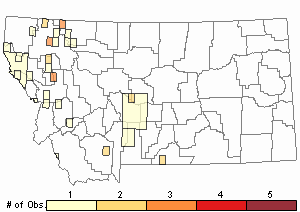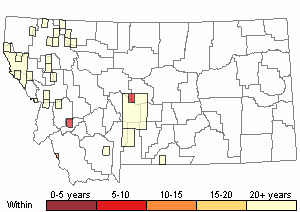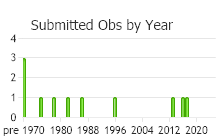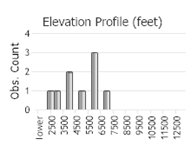View in other NatureServe Network Field Guides
NatureServe
Montana
Utah
Wyoming
Idaho
Wisconsin
British Columbia
South Carolina
Yukon
California
New York
Middle Plagiomnium Moss - Plagiomnium medium
Other Names:
Mnium medium
General Description
Plants: Acrocarpous (Vitt 1988), unbranched, growing in open tufts (Crum and Anderson et al. 1981) or mats (Lawton 1971), green, or green with yellow tones (FNA 2014). Fertile stems upright with brown tomentum proximally (Lawton 1971), 20-40 mm tall; infertile stems sometimes reaching 80 mm (FNA 2014), creeping (Lawton 1971), spreading or bent downward (Crum and Anderson et al. 1981).
Leaves: Smaller and more distant below (Crum and Anderson et al. 1981), wavy and somewhat twisted, bent or curved when dry, plane (FNA 2014) and spreading about 45 degrees or more when damp (Crum and Anderson et al. 1981), 3.5-10 mm in length (FNA 2014), 3-4 mm in width (Lawton 1971), often widest in the middle and sometimes rather broad, or occasionally obovate, narrowing to a curved, obtuse leaf tip, or tip sometimes more narrowly-angled, with a mucro or occasionally-toothed cusp; base extending well down the stem; margins flat, sharply- or sometimes dully-dentate from the apex to near the bottom; costa reaching or exceeding the leaf tip (FNA 2014).
Leaf Cells: Marginal teeth 1- to 2-celled, or seldom 3-celled; cells at the leaf edge arranged in 1 layer, long and thin, in 2-4 series; medial laminal cells usually somewhat long, or occasionally with width about the same as length, the cells much smaller near the margins, occurring in up-and-down rows or obliquely-rowed, porose (FNA 2014), firmly- to thickly-walled, the angles thick (Crum and Anderson et al. 1981).
Phenology
Fruit ripens in the last part of spring (FNA 2014).
Diagnostic Characteristics
The variation of characters within and among populations of Plagiomnium makes identification difficult without fertile plants (FNA 2014).
Range Comments
North American Range
AK to NL and NS, WA to MT and from that border s to CA, NV, UT and CO, also SD to MI and IL, also PA, NY, VT and ME, TX, AR, TN and VA (FNA 2014). Known in Montana from Carbon, Flathead, Gallatin, Glacier, Granite, Judith Basin, Lake, Lincoln, Madison, Mineral, Missoula, Park, and Sanders Counties (Elliott and Pipp 2016).
Observations in Montana Natural Heritage Program Database
Number of Observations: 41
(Click on the following maps and charts to see full sized version)
Map Help and Descriptions
Relative Density

Recency



 (Observations spanning multiple months or years are excluded from time charts)
(Observations spanning multiple months or years are excluded from time charts)
Habitat
Damp soil and humus (Elliott and Pipp 2016), and soil overlying stone (Lawton 1971) in wet woods, near watercourses and springs (Crum and Anderson et al. 1981), swamps. Occurring from lowlands to medium altitudes (FNA 2014).
Reproductive Characteristics
Archegonia and antheridia associating in the same bract cluster. Seta mostly multiple, occasionally to 7 per perichaetium, 20-50 mm tall (FNA 2014), russet proximally, becoming yellow distally (Lawton 1971). Capsule 3-4.5 mm in length, drooping, with an obscure neck (FNA 2014), ochre; stomata in several rows, sunken with guard cells partially hidden; exostome teeth yellow with green tones, papillose; endostome processes ochre, widely perforate with papillose, knobby cilia (Lawton 1971).
Stewardship Responsibility
References
- Literature Cited AboveLegend:
 View Online Publication
View Online Publication Crum, H.A. and L.E. Anderson. 1981. Mosses of Eastern North America. 2 volumes. Columbia University Press, New York. 1328 pp.
Crum, H.A. and L.E. Anderson. 1981. Mosses of Eastern North America. 2 volumes. Columbia University Press, New York. 1328 pp. Elliott, J.C. and A.K. Pipp. 2018. A Checklist of Montana Mosses (1880-2018). Updated 3 January, 2020. Montana Natural Heritage Program, Helena, Montana. 73 pp.
Elliott, J.C. and A.K. Pipp. 2018. A Checklist of Montana Mosses (1880-2018). Updated 3 January, 2020. Montana Natural Heritage Program, Helena, Montana. 73 pp. Flora of North America Editorial Committee, eds. 2014. Flora of North America North of Mexico. Volume 28. Bryophytes: Mosses, Part 2. Oxford University Press, Inc., NY. xxi + 702 pp.
Flora of North America Editorial Committee, eds. 2014. Flora of North America North of Mexico. Volume 28. Bryophytes: Mosses, Part 2. Oxford University Press, Inc., NY. xxi + 702 pp. Lawton, E. 1971. Moss Flora of the Pacific Northwest. Hattori Botanical Laboratory. Japan: Yamabuki-cho, Shinjuku-ku, Tokyo. 362 pages plus appendices.
Lawton, E. 1971. Moss Flora of the Pacific Northwest. Hattori Botanical Laboratory. Japan: Yamabuki-cho, Shinjuku-ku, Tokyo. 362 pages plus appendices. Vitt, D. J. Marsh, and R. Bovey. 1988. Mosses, Lichens & Ferns of Northwest North America. Seattle, WA: University of Washington Press. 296 p.
Vitt, D. J. Marsh, and R. Bovey. 1988. Mosses, Lichens & Ferns of Northwest North America. Seattle, WA: University of Washington Press. 296 p.
- Additional ReferencesLegend:
 View Online Publication
View Online Publication
Do you know of a citation we're missing? Elliot, J. C. 1993. Second checklist of Montana mosses. Unpublished report. U.S. Forest Service, Region 1. Missoula, MT. 45 pp.
Elliot, J. C. 1993. Second checklist of Montana mosses. Unpublished report. U.S. Forest Service, Region 1. Missoula, MT. 45 pp. Flowers, S. 1973. Mosses: Utah and the West. Brigham Young University, Provo, Utah. 567 p.
Flowers, S. 1973. Mosses: Utah and the West. Brigham Young University, Provo, Utah. 567 p. Lawton, E. 1971. Keys for the Identification of the Mosses on the Pacific Northwest. Reprinted from 'Moss Flora of the Pacific Northwest'. Published as Supplement No. 2 of the Journal of the Hattori Botanical Laboratory. Nichinan, Miyazaki, Japan. 66 pp.
Lawton, E. 1971. Keys for the Identification of the Mosses on the Pacific Northwest. Reprinted from 'Moss Flora of the Pacific Northwest'. Published as Supplement No. 2 of the Journal of the Hattori Botanical Laboratory. Nichinan, Miyazaki, Japan. 66 pp. Malcolm, B., N. Malcolm, J. Shevock, and D. Norris. 2009. California Mosses. Nelson, New Zealand: Micro-Optics Press. 430 pp.
Malcolm, B., N. Malcolm, J. Shevock, and D. Norris. 2009. California Mosses. Nelson, New Zealand: Micro-Optics Press. 430 pp. Smith, A.J.E. 1980. The Moss Flora of Britain and Ireland. Cambridge University Press, Cambridge. 705 pp.
Smith, A.J.E. 1980. The Moss Flora of Britain and Ireland. Cambridge University Press, Cambridge. 705 pp.
- Web Search Engines for Articles on "Middle Plagiomnium Moss"





